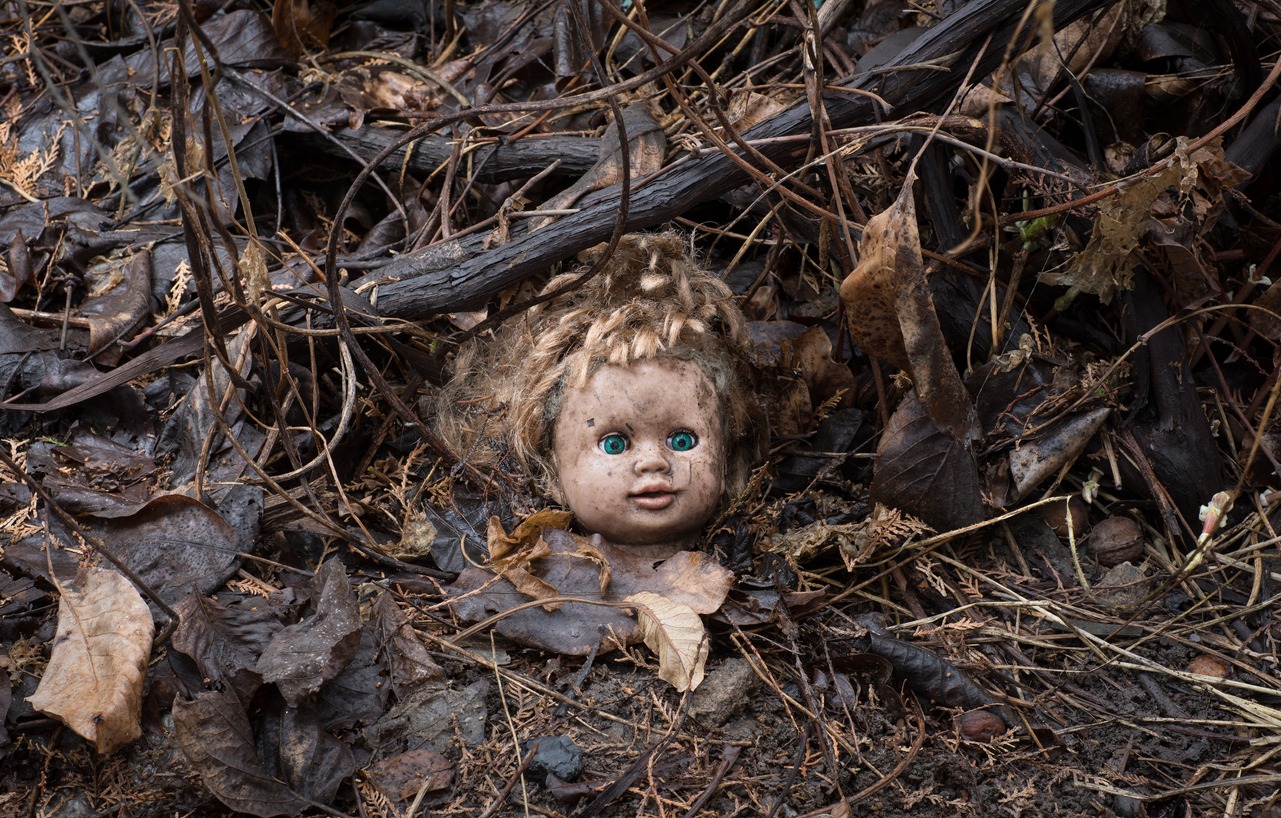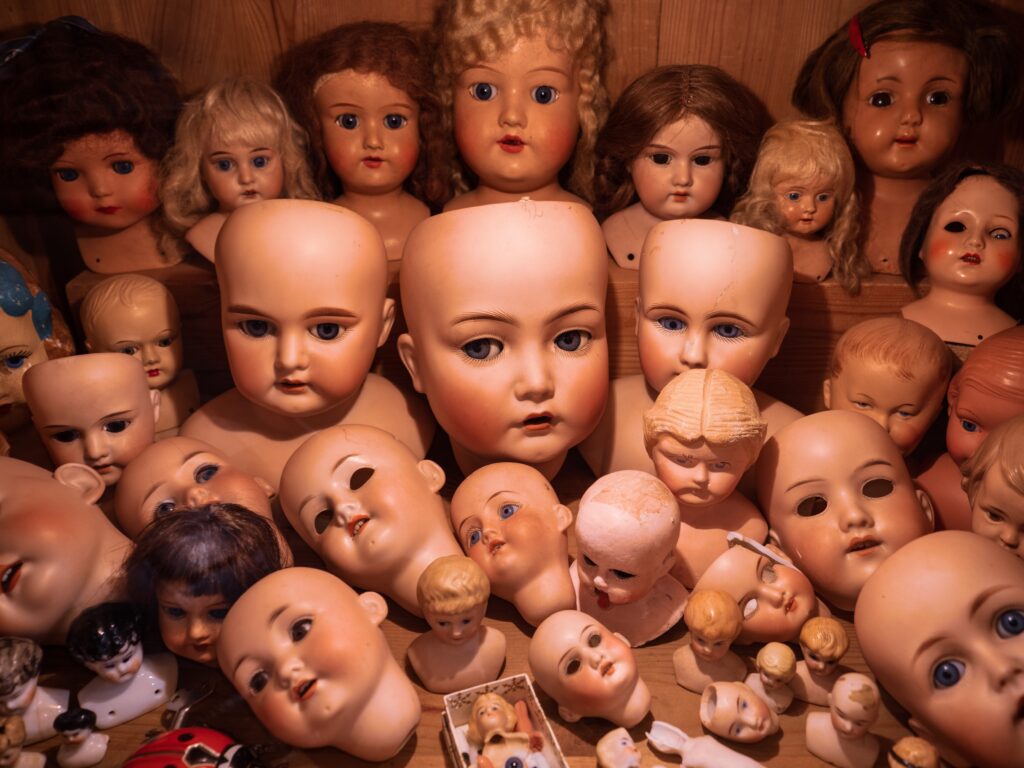This doll factory in Spain has an uncomfortable way of getting under your skin. It was abandoned sometime in the ’80s, but for some reason everything was left behind—boxes of doll parts, machinery, half-finished dolls still lying on the assembly line—everything. It’s as if everybody just vanished in the middle of the work day. At the time the factory was in operation, porcelain dolls were commonly made with human hair, which somehow makes these things even creepier.
The three-story building remains largely unchanged to this day, except for the floor in one wing, which collapsed at some point. There isn’t even much graffiti to show that other people have explored it. According to one photographer who visited the factory, the entire third floor was covered in a mountain of ceramic arms and legs. This was followed by the unintentionally creepy “the heads and bodies were much more rare.” This place is a horror movie waiting to happen.
History of Dolls
Dolls are said to have existed as early as the Paleolithic Era (roughly 2.5 million years ago to 10,000 B.C.). The eldest one, discovered in Siberia in 2017, had a head carved from soapstone and a body made of organic materials which have since then decomposed. It is believed to be over 4,500 years old.
Wooden paddle dolls from Ancient Egypt also appeared to be popular. Probably because they were fashioned of such brittle materials as wood, fur, or fabric, dolls have never been discovered in prehistoric burials. However, a piece of a Babylonian alabaster doll with moving arms has been discovered. In certain Egyptian cemeteries, dolls with long, flowing hair made of clay or wood beads on strings and dating to between 3000 and 2000 BC have been discovered. They are constructed of flat slabs of wood and are geometrically painted.
According to some scholars, the religious doll predates the toy and certain early dolls may have had religious significance. In the past, girls who were ready to get married would dedicate their old dolls to deities in Greece and Rome. In early Christian catacombs as well as in ancient Egypt, Greece, and Rome, dolls were interred with children. Numerous dolls, including those with woolen heads and those dressed in colored wool frocks, as well as old stuffed or rag dolls, have been discovered.
Germany’s Nürnberg, which was the major producer of dolls and toys from the 16th through the 18th century, had Dochenmacher, or doll manufacturers, as early as 1413. Creating mostly fashion dolls, Paris was another early major maker of dolls. Beginning in the 16th century, dolls’ houses gained popularity throughout Europe.
Wood, terra-cotta, alabaster, and wax were used to make doll heads; Augusta Montanari and her son Richard (c. 1850–1877), who popularized baby dolls, developed this last method in England. Unglazed bisque (ceramic) doll heads and glazed porcelain (Dresden) doll heads gained popularity around 1820. A French bisque doll created by the Jumeau family in the 1860s included a swivel neck; the body was constructed of kid-covered wood or wire or kid packed with sawdust, a style of fabrication that persisted until it was replaced by molded plastics in the 20th century.
The 19th century saw the invention of dolls with socket joints, moveable eyes, talking dolls, walking dolls, paper doll books, and dolls made of gutta-percha or India rubber. The lavishly costumed Parisian bisque fashion dolls and the smaller “milliner’s models” peaked between 1860 and 1890.
The Inca and Aztec burials unearthed, particularly those close to Teotihuacán’s pyramids, may include the earliest American dolls. Most colonial dolls were based on European designs. The Pueblo Indians’ kachina doll is notable among American Indian dolls.
Dolls are more frequently used as festival decorations in Japan than as toys. Girls aged 7 to 17 visit each other’s collections during the girls’ festival held in March, where dolls depicting the emperor, empress, and their court are on exhibit. In keeping with a more than 900-year-old tradition, refreshments are served to the visitors after first serving their majesties. Between the first May after their birth and the time they are roughly 15 years old, Japanese males also celebrate an annual doll festival. To promote noble values, warrior figurines, weapons, banners, and groupings of famous figures are on exhibit.
Both Hindus and Muslims in India gave child brides lavishly clothed dolls. Girls in Syria who are old enough to get married hang dolls from their windows. Every mature woman of the Mfengu tribe of South Africa receives a doll to keep for her first kid, and with the birth of her second child, the mother is given a second doll to keep for her second child.
Teddy bears, the Kewpie Doll, the Bye-lo Baby, who closed her eyelids while sleeping, the Dydee and Wetsy Betsy dolls, the Barbie doll, the Cabbage Patch Kids, and the American Girls Collection were all popular dolls during the 20th century. (1986).
Notable Haunted Dolls
In recent years, a number of supposedly haunted dolls have surfaced in popular culture:
Robert
Robert is a doll that Robert Eugene Otto, a painter and novelist from Key West, formerly had and is now on exhibit at the East Martello Museum in Key West, Florida. It is said to be haunted by ghosts.
Annabelle
Raggedy Ann doll named Annabelle is on exhibit at The Warren’s Occult Museum in Monroe, Connecticut, where Ed and Lorraine Warren claim she is haunted. The Conjuring and Annabelle movies both drew their inspiration from the doll.
Letta the Doll
Kerry Walton of Brisbane, Queensland, Australia has made several television appearances with a doll he claims to have discovered in an abandoned building in Wagga Wagga, Australia, in 1972[9]. Walton claims to have given the doll the name “Letta Me Out” due to its allegedly supernatural qualities. Walton asserts that witnesses saw the doll move in front of them and that it left clear scuff tracks around the house.
Okiku
Modern Japanese folklore claims that in 1918, a young man by the name of Eikichi Suzuki bought for his younger sister, Okiku, a large doll from Hokkaido, who gave the doll her name. When Okiku passed away, her family started to think that Okiku’s ghost was residing in the doll and that the doll’s hair was sprouting. In Hokkaido’s Mannenji Temple, where the doll is kept, a priest is said to regularly trim Okiku’s still-growing hair.
Mandy
Mandy is a porcelain baby doll that was donated to the Quesnel Museum in British Columbia in 1991. Mandy is said to have supernatural abilities because her eyes are said to follow museum visitors. Mandy was made in England or Germany between 1910 and 1920. The Montel Williams Show has featured the doll.
Pulau Ubin Barbie
A Barbie doll displayed in a memorial temple in Singapore is known as Pulau Ubin Barbie and is said to have supernatural abilities.


